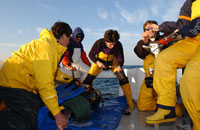


We were able to get the final 15 archival tags out on small bluefin tuna on Saturday morning, and we topped off the live wells so that 15 fish were aboard swimming in circles below deck. At this point we have archival tagged 112 Pacific bluefin in the past week, and collected 30 live fish for the Tuna Research and Conservation Center. We’ve also placed 7 archival tags in albacore (we stopped tagging albies when I realized how many bluefin were around). This total puts our team at a total of about 550 electronic tags on Pacific bluefin. For the first time in years- all our electronic tags aboard the F/V Shogun have been deployed and there are no more tags left to put out- what a spectacular last weekend. Fishing did slow on Sunday- but we did get some super sized albacore on the trolling rods and we were treated to a rare showing of a killer whale pod near the boat- in albacore country. Our Ph.D students, Nishad and Dan requested a few more yellowfin to sample and sure enough Norm found us some nice sized yellowfin as we headed about 10 miles to the south. With the yellowfin sampling completed our trip was 100% scientifically accomplished. Dan Madigan had requested samples for an ecological isotopic study of California Current tunas. He’s examining the nitrogen and carbon isotopes and literally taking the saying you are what you eat to the research bank. He’s able to examine albacore, yellowfin and bluefin and distinguish who eats fish and who eats the crustaceans, krill and “feed Layer” animals just from taking a small liver and muscle sample. We also took some samples for a mercury content study we’re doing on bluefin. So the final totals are 160 bluefin for science- 30 of these live for the TRCC collections, over 50 samples of albacore and yellowfin for science for Stanford Ph.D students. Its been an inspiring time- and a trip that will go down with 1999- when we conventional tagged over 100 large bluefin-and 2002 when we put out over 130 archival tags. Our science will help to generate the knowledge we need to manage bluefin tuna on the west coast of North America and the data will trickle in from this large scale deployment for years. Scientific papers are under the links that say scientific data or publications. Our gratitude is deep to the crew of the Shogun with Captains Norm and Bruce helping us for years with this remarkable legacy of bluefin research aboard the Shogun. Our scientific team has been top notch and once again- our thanks to our technicians, students and researchers from the TRCC and Stanford University.

















